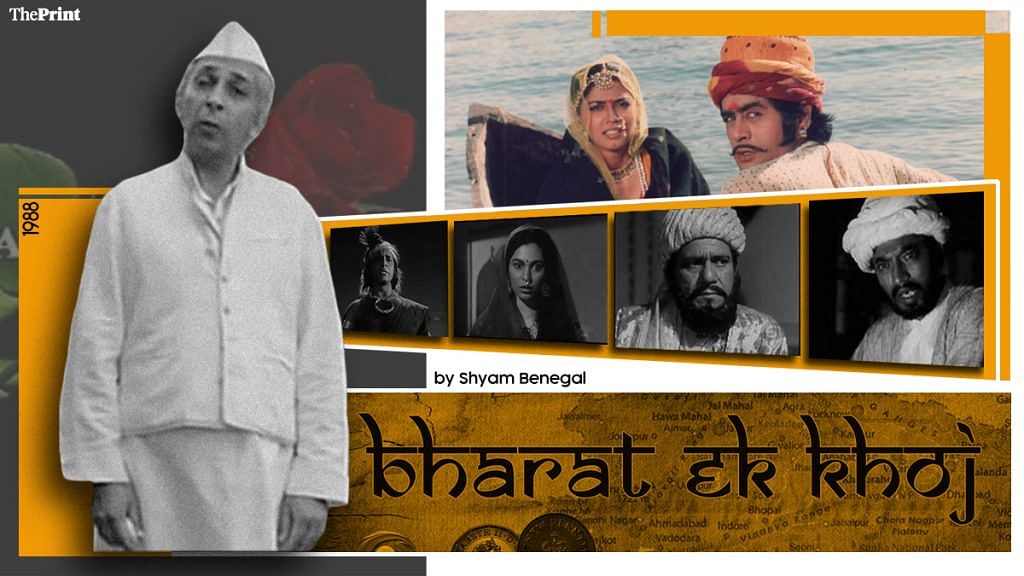Crowds of people walk across a village with cries of ‘Bharat Mata ki Jai’ reverberating as Jawaharlal Nehru takes the stage. Stationing himself in front of the mic, he asks, “What do you mean by that cry, who was this ‘Bharat Mata’, whose victory do you want?”
This was just one of the heavy-duty, vital topics addressed every Sunday at 11 am on Doordarshan in Shyam Benegal’s monumental series, Bharat Ek Khoj.
Aired between 1988-89, the 53-episode long series, with each episode spanning anywhere from 30 minutes to 90 minutes depending on the topic being covered, brought to life the 5,000 year-old history of India and the subcontinent in perhaps the most consolidated manner possible. The ambitious project wasn’t simply a deconstruction of history, but a confluence of its many cultures.
Based on Nehru’s book, The Discovery of India, which he wrote while in prison at the Ahmednagar fort for participating in the Quit India movement, the show was an attempt to bring to life what Nehru wrote while also bridging the gaps in between.
“I developed two viewpoints — one is that of Nehru (narrated by Roshan Seth) and the other is a counter viewpoint (narrated by Om Puri), which is a contemporary voice that fills blanks or brings in different perspectives,” Benegal said in an interview with Prasar Bharti.
Also read: Fauji: The show that launched a broody, chain-smoking SRK on the path to Bollywood glory
From Indus Valley to Independence
Beginning from the Harappan Civilisation, the show is an epic sweep that covers aspects of Indian history such as the formation of caste, the reign of Chanakya and Chandragupta Maurya and then Ashoka, the rise of the Mughal empire and its descent at the hands of Maratha ruler, Shivaji, the arrival of the British East India Company and the freedom struggle.
It has several episodes dedicated to southern India such as the history of the Chola empire, and it also shines a spotlight on some of India’s major literary mythological epics, such as the Ramayana, Mahabharata, Cilappatikaram and Shakuntala.
It took more than 500 actors (including Naseerudin Shah, Shabana Azmi, the late Om Puri and Irrfan, Roshan Seth, Ila Arun and many more), 25 writers headed by Shama Zaidi, 144 sets whose designs spanned several centuries, three-and-a-half years of meticulous research by 22 historians with the help of many government institutions, including the Archeological Society of India, and roughly 20 months of shooting.
Also read: Trishna, the popular 1985 Doordarshan adaptation of Pride & Prejudice, is now on YouTube
History made interesting
For many children of the ’80s, the show was a great source of history and perhaps a more interesting way to learn and understand a subject that is typically considered boring. So it was no surprise that when the government decided to rerun old Doordarshan shows like Ramayan and Byomkesh Bakshi during the coronavirus-induced nationwide lockdown, Bharat Ek Khoj was also in high demand.
Deepa Srivastav, who runs her own boutique, tells ThePrint, “My childhood was enriched with these episodes. I learnt a lot about history and fell in love with it. The show was very well written, documented and wonderfully depicted.”
Many from that generation even complain about how quality of Indian television has nosedived into melodramatic daily soaps with no substance. Daljit Singh, an entrepreneur, reminisces, “Those were the days when such top-class serials were made and shown on Doordarshan. Now only regressive serials are being made by incompetent people whose only aim is to earn money.”
Also read: Mungerilal Ke Haseen Sapne: India’s Walter Mitty and a popular political tool
The many characters that made Bharat
Benegal was bold in his portrayal of many characters such as that of Duryodhan and even Allaudin Khilji. Both are figures that have generally been portrayed as greedy, jealous and beyond redemption, but Puri’s portrayal of both (many actors played different roles in different episodes) was in a more humane and sympathetic light.
It’s hard to imagine that now, given that any historical character’s portrayal on screen is now fodder for political points, but Benegal didn’t face any problems. “I didn’t face any political pressure of any sort. There was no constraint of any kind, there was no particular line I was supposed to take,” Benegal said as he believed he was exploring India’s history in the most dispassionate and fair manner possible. Even Naseerudin Shah as Shivaji was perhaps the most balanced representation of the Maratha ruler.
While an enormous amount of effort was put in by Benegal and co. in ensuring accuracy and authenticity, there were gaping holes in the trajectory the show followed. Benegal’s choice to not even address the contribution of BR Ambedkar in the formation of India, for example, reflected that while there was a counter-narrative in Om Puri’s voice, the show remained Nehruvian in its telling.
Bharat Ek Khoj was ahead of its time in its level of production and is perhaps one of Benegal’s best works as a director and writer. But if someone were to remake it in the 21st century, Benegal said, it is essential for them to be “mad”. At a time when India is grappling with issues of citizenship and what it means to be Indian, a look at the diversity that this show spanned might be just what the doctor ordered.
